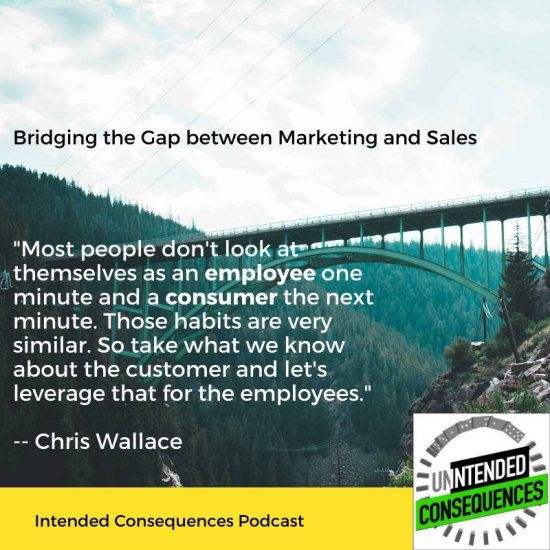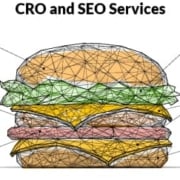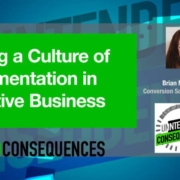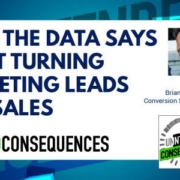The Gulf Between Marketing and Sales Solved (and it’s not what you think)
Sales and marketing. Two functions critical to a business’s success. They work tightly, arm-in-arm to build awareness, engage prospects and help them choose the best solution for their problem. They have common goals and cooperate closely to achieve them. The mutual respect and gratitude they have for one another is palpable.
If you’re wondering what planet I’m on, you’re not alone.
From the first time something was sold, sales and marketing have worked together.
- God created desire by positioning the fruit as forbidden. The serpent closed the deal.
- Marketers created the gold rush. Salespeople sold the picks and shovels.
- Sears wrote the catalog. Roebuck shipped the merchandise.
Yet, not all is well in sales and marketing land.
“Marketing needs to generate more leads,” says sales.
“Sales needs to follow up on the leads we’re sending them,” says marketing.
“The leads marketing is sending aren’t qualified,” says sales.
“Sales isn’t selling the right products,” says marketing.
We are usually hired by marketing to optimize a website. We learn a lot from salespeople when we interview them.
Yet, we often don’t have access to the CRM — the Customer Relationship Management system — because “it belongs to sales.”
This gulf, this canyon, this gaping sinkhole between sales and marketing has been around for as long as I’ve been in the business. That’s why I invited Chris Wallace to be on the podcast. He is the Co-founder and President of Innerview, an agency that is totally focused on this problem.
I was skeptical at first. This problem also exists with the customer support teams and the training teams. By the time we were done talking, I knew his solution was perfect.
Find out how he convinced me.
Sales vs. Marketing
“The biggest reason organizations struggle with this is information typically moves in one direction. Information flows from the top down. And the marketers are really the ones developing the go to market strategy and developing the products. And then that gets, for lack of a better word, thrown over the wall or pushed down the funnel toward the sales organization.”
The Face of our Brand
“And what we’re finding to be the best way to sort of bridge that gap is to disrupt that one way flow and really increase the two way dialog and collaboration and really helping marketers look at their their sales teams, their front line, Iraqi sales, customer service, even technicians and even non selling roles, not revenue generating roles. And looking at those folks really as the face of their brand and an audience that they need to engage in and really win over looking at them as if we can really win their hearts and mind that tell them what to do but win their hearts and minds the way we’re out there trying to win customers hearts and minds every day. We know we can. We can. Like you said, we can build that bridge. We can we can close that gap in a significant way.”
Sales/Customer support is a channel that needs to be optimized!
Should marketing look at [sales] as another channel to get its message out? And be optimizing that channel the same way would be a Facebook advertising campaign or search engine optimization program or a paid search advertising campaign?
“We run it like a marketing campaign. We treat that like any channel that “talks” to the customers. We segment them based on how they talk to the customers and we measure how aligned they are to their brand story.”
Metrics for Marketing to Employees
“How well is your brand message — your brand story — transferring from your your corporate marketing department down to each one of these customer-facing channels? Its internal market research. So everything that we do is led by gathering the attitudes and opinions and perceptions about product service, brand positioning — all those things — and using the data that we have to target those audiences with new campaigns, new messages, in an effort to really win them over. Or fill the gap.
Don’t Tell Sales. Ask!
“They’re focusing so much of their time — and their effort and their resources — telling sales what it is that they need to do, and not enough time asking them what they think. And it doesn’t mean that you’re going to completely change a product. It doesn’t mean that you’re going to go back and completely redo your campaign.”
“But if you’re asking somebody what they think, if you understand thier starting point, if you want to get them from point A to point B, if you are constantly guessing at what message is going to resonate with them, to move them from point A to point B, and you spend all your time, effort, energy blasting that message at them. In this case, it could be product trainings or product manuals or whatever the case may be. If you spend all your time guessing and pushing messages out, you’re actually pushing your “audience” further away.”
Timing is Really Important
“The timing of this is really important. The sales team feels like you’re out in market with it before they’re even prepared to talk about it. Right. The phone start ringing before before they’re even prepared. That happens a lot. We see it all the time. But the timing is really important. But really that that the answer is ask versus tell.”
Put down the Saleshose
“Don’t try to make them experts right way, try to help them build momentum, try to get them comfortable with something. Don’t try to get them to swallow the entire thing whole. So when you talk about trying to keep it top of mind, a great way to keep things top of mind is to feed them interesting little nuggets. Bit by bit by bit over a period of time, rather than attaching the firehose to their face. Almost every organization that we come across goes with the firehose approach.”
Deliver Content like a Marketer
“We’re developing anything from webisode concepts where organizations are creating content. And I’m not talking about corporate videos, somebody sitting behind a desk telling you how important something is. I’m talking about creating content that looks more like what people are watching on YouTube and Netflix and distributing that to their frontline teams. Having themes that really engage them.”
Get Creative like a Marketer
“Instead of doing your typical product trainings, we’re developing escape room concepts. We’re working with virtual reality companies — VR. It has a tremendous application for employee engagement in front line readiness.”
Be Dynamic like a Marketer
“The way that you’re able to engage with your your customers is more dynamic — a marketer — now than it ever has been. And we look at that and say, ‘Take a lesson from that.’ Look at all those different drips and those different nuggets and channels that you’re distributing small pieces of information through and find different vehicles to get that information out to your own people.
Employees Act like Consumers
“Most people don’t look at themselves as an employee one minute and a consumer the next minute. Those habits are very similar. So take what we know about the customer and let’s leverage that for the employees.”
When you get back to the office…
Instead of using sales to learn more about your customers, learn to see sales AS your customers.
When marketers get fresh data about their market, it’s like their birthday. You need to find that same excitement learning about the sales, training and customer support teams you work with. Think about the next thing you have coming up, that you need to get right. What percentage of your sales team are women vs. men? What percentage are humanists, who build relationships vs. methodicals who persuade with logic? How do you construct the “Whats in it for me” arguments that will grab their attention and make your campaign a success? How do you equip sales and support to be successful with your product?
You may have to start working on a budget that includes this new marketing channel: the one inside your company.
Now go science something.
Links and Resources
- Connect with Chris
- Learn more about InnerView
- Check out the brand transfer score blog
Terms
- How to Compare Data When You Move from Google Analytics to GA4 - April 7, 2023
- CRO and SEO Working Together with Jason Fisher - November 17, 2022
- Why Web Design for Conversion Needs Science - May 4, 2022

















Leave a Reply
Want to join the discussion?Feel free to contribute!